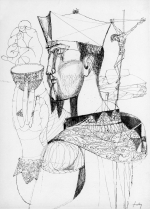The Graphics of Lajos Szalay
Three Gorges Museum

Lajos Szalay was probably one of the greatest draughtsman known to the history of art, whether from a Hungarian or international perspective. By presenting 250 of the most beautiful pieces of its collection, the Foundation would like to introduce an outstanding representative of European draughtsmanship to the Chongqing public.
There was a reason why Pablo Picasso, perhaps the most controversial figure of 20th-century art, called him “the next greatest graphic artist in the world”—second, that is, only to himself. To this day, art historians in Argentina, where Szalay taught for over a decade, are likely to distinguish “pre-Szalay” and “post-Szalay” periods: such was the influence of his work on the young graphic artists of the country.
The collection of the Kovács Gábor Art Foundation holds more than 600 of Lajos Szalay’s graphic works, and at present this collection offers the most comprehensive overview of the oeuvre. About half a thousand drawings recently recovered from the artist’s estate, held in his San Diego house by his daughter, add a special value to this collection. The artist himself must have considered these pieces very important, because he carried them with himself throughout his “wanderings,” as indispensable “documents” of his life. Constantly growing as he moved from Budapest to Paris to Buenos Aires to New York, this group of works were to come home on the occasion of the Budapest oeuvre exhibition that celebrated the 100th anniversary of the master’s birth.
By presenting 250 of the most beautiful pieces of this collection, the Foundation would like to introduce an outstanding representative of European draughtsmanship to the Chongqing public, hoping that the drawings will also reveal more of the roots of Christian culture, its main ideas and their unique visual representation. Chinese visitors will probably delight in this mastery of ink drawing, a technique their own culture has considered one of the most important means of expression for millennia. Providing a taste of the most valuable features of European graphic art, this exhibition effects a special encounter of East and West, of tradition and modernity, of intellectual content and technical virtuosity.
